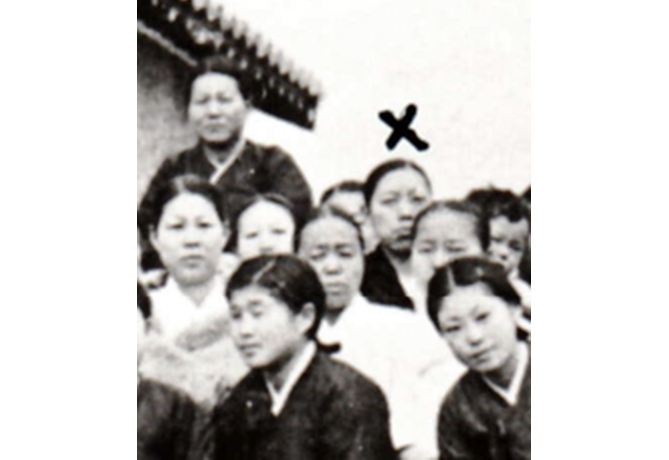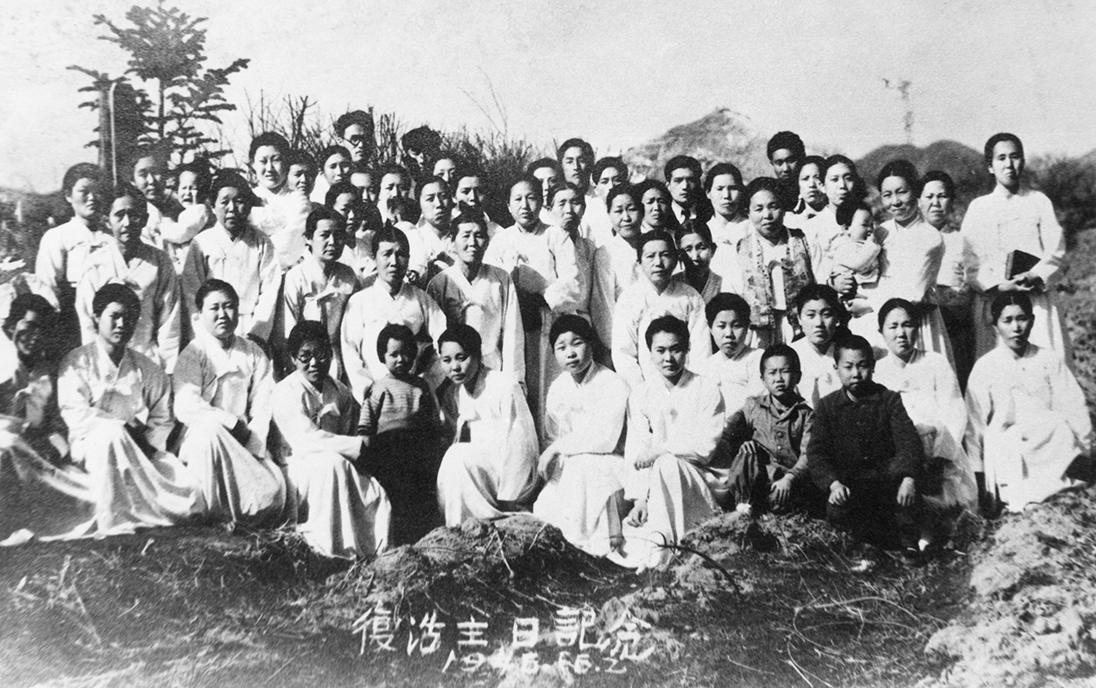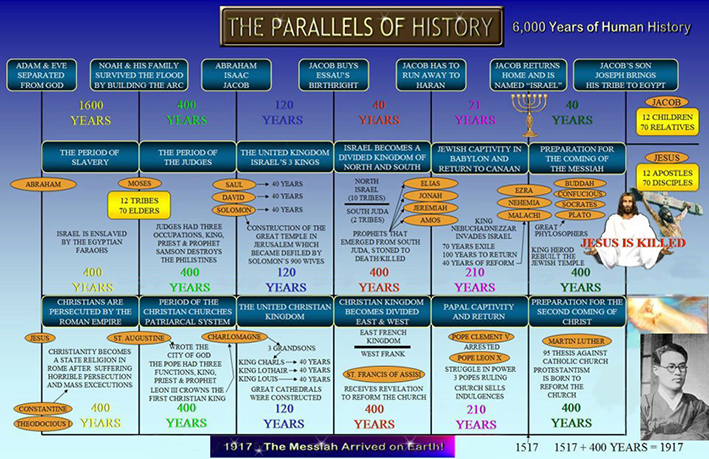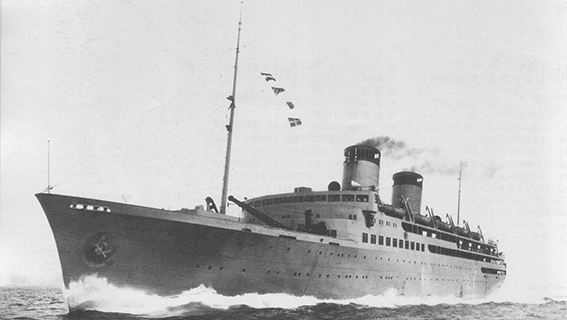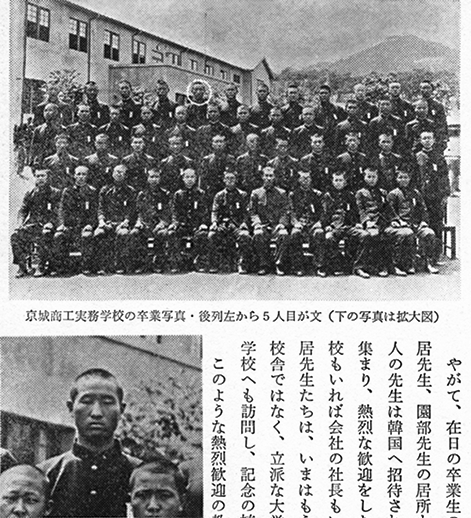Updated January 13, 2022
Moon had a girlfriend from at least 1941. She introduced him to Kim Baek-moon! Moon stole many ideas for the Divine Principle from Kim, including the structure of the DP and the parallels of history! ( see Theology and Kim Baek Moon)
Moon had a girlfriend at the Jesus Church in Myungsudae, Heukseok-dong, Seoul. (It was also called the Myungsudae Church 明水台教会.) The girl’s name was 朴雲女 Park Un-nyeo. The Japanese pronunciation is Boku Unjo パク・ウンニョ. She identified herself in the photograph below, and she, herself, wrote the ‘X’. The upper photo is a section of the one below.
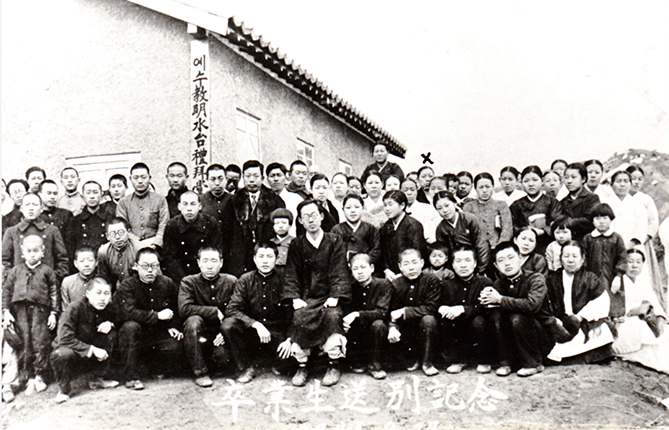 ▲ Moon is crouching in the front row, third from the left – so they are both in the same photograph.
▲ Moon is crouching in the front row, third from the left – so they are both in the same photograph.
At an interview in Seoul in the early 1990s Park Un-nyeo spoke about her time with Sun Myung Moon. She was visibly affected when she saw the photo of the February 27, 1941 graduation of herself and Moon – memories came flooding back to her. There was a feeling that something hidden was being brought out into the open. She was happy to be given a copy of the photo to take home. She was then in her seventies, she lived in Seoul in poverty. She was friends with Eu Hyo-min.
One month after their 1941 graduation from the Jesus Church, Park and Moon traveled together to Japan when they both went there to study. They crossed from Busan to Japan on the same ship on March 31st, arriving in Japan the next day. Park went to study Japanese language in Tokyo – and she spoke it very well.
Park said that while at the Jesus Church with Moon in Seoul, and while they were both students in Tokyo, Moon was a typical student. He did not study more than anyone else, neither did he pray exceptionally. He lived the life of an ordinary student in Japan in 1941-1943, going to coffee shops, etc. Moon never talked about being the messiah, neither did he talk about any special experience with Jesus. He did not talk much about God. (Yamaguchi Hiroshi, a Japanese journalist who wrote a book about Moon, also during his research did not find Moon to be very religious during his school days in Korea – see extract from his book below.)
In Tokyo, Moon went to a Technical High School to study electrical engineering. He attended evening classes from 6:00 to 9:30 and worked during the days to pay for his schooling. (Moon never went to Waseda University in Tokyo.) His closest friends in Tokyo were communists. (see Michael Breen note below.)
Apparently it was a Japanese member of the 777 couples who started the story that Moon had three bibles in his Tokyo lodgings – Korean, Japanese and English. However, a Japanese Unification Church publication ‘The History of the Unification Church’ states: “International magazines on politics and economics always lay on the top of his desk. Inside the magazines, there were many notes written in coloured pencil.” (ref. Yamaguchi)
Park Un-nyeo said that Moon was never arrested by the Japanese police for pro-Korean activities, or anything similar, in Japan. (see Mr Nakao note below.)
In November 1943 Moon was matched to Choi Seon-gil. They married in 1945.
Back in Seoul, in January 1944 Moon started work for the Kashima gumi company. That October Moon was arrested in Seoul – some of his friends were communist and when they were arrested his name was found in their possessions. This led to Moon’s arrest.
It seems that Park did not leave Japan with Moon. After her return to Korea she joined Kim Baek-moon’s messianic group in Seoul – the Israel Monastery. It was Park Un-nyeo who introduced Moon to Kim Baek-moon in the fall of 1945. By that time Choi Seon-gil was pregnant with Moon Sung-jin who was born on April 2, 1946.
The last time Park Un-nyeo saw Moon was in 1946.
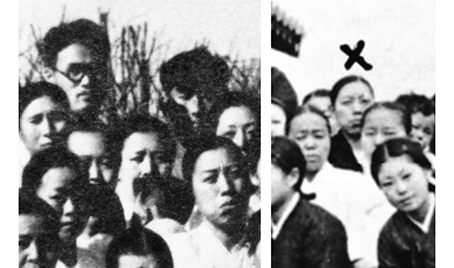 ▲ Kim Baek-moon is top left. The woman on the right in the photo with Kim can clearly be identified as Park Un-nyeo when compared with the Myungsudae photo on the right.
▲ Kim Baek-moon is top left. The woman on the right in the photo with Kim can clearly be identified as Park Un-nyeo when compared with the Myungsudae photo on the right.
The whole picture, dated June 2, 1946 is shown below. It was taken just a few days before Kim and Moon traveled together to Pyongyang.
In the 1990s Park Un-nyeo was still convinced that Kim was the awaited messiah. At the interview she got out her well-thumbed bible and used all the same quotes that Moon later used to prove he himself was the awaited Lord of the Second Advent. It seemed clear that Moon got many of his ideas from Kim. (Kim was born in 1917, and it was Kim who developed the parallels of history to prove that he was the messiah. Kim was born 400 years after Martin Luther’s 1517 declaration. Moon was born in 1920.)
Park seemed to look up to Kim Baek-moon as a father figure. She explained that she was expecting Kim Baek-moon to return. He had died some years earlier, in 1990.
Park emphasized that Moon had only become interested in the idea of being a religious leader after spending time with Kim Baek-moon. Moon saw how Kim’s followers became more devoted to him in 1946. On March 2nd that year, Kim Baek-moon had an experience with Jesus on a mountain in Gyeonggi Province. Jesus appeared for an hour between 11am and noon. This was during a worship service with 33 faithful members present.
Moon was with Kim’s group from late 1945 to June 1946. Moon heard about Kim being called by Jesus to establish a new Israel in Korea. To that end, Kim began to systematize his theology and he published three books, in 1954, 1958 and 1970. In Kim’s church, 1946 was defined as the first year of the Completed Testament Age.
It is not known if Moon ever spoke about his own alleged meeting with Jesus when he was a teenager (there were no witnesses). Park Un-nyeo, Moon’s own cousins (ref. Sontag below) and Moon’s fellow High School students in Korea (ref. Yamaguchi below) certainly never heard about it from Moon.
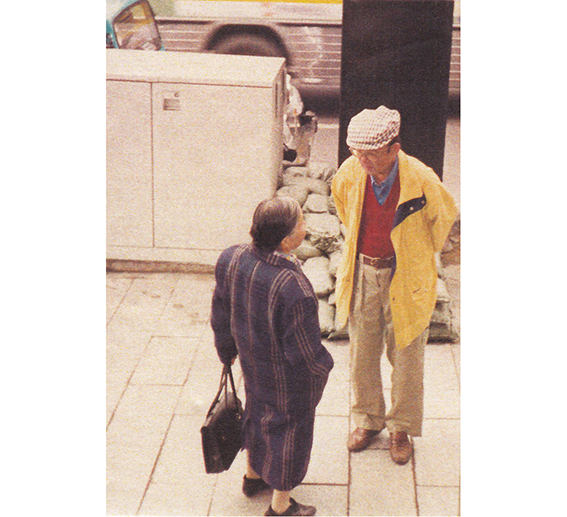 ▲ Park Un-nyeo and Eu Hyo-min were good friends – here seen together in Seoul in the 1990s on the day of the interview.
▲ Park Un-nyeo and Eu Hyo-min were good friends – here seen together in Seoul in the 1990s on the day of the interview.
Eu was a polite man and genuinely cared about those who had been abused by Moon. Eu Hyo-min used money from his business to support various people. Eu said that Park and Moon had been lovers, and that maybe Moon had promised to marry her. Their relationship had lasted several years. It was clear that Park felt that she had been betrayed by Moon and came to hate him. Park said that Moon was very clever at manipulating women.
(Did Park feel used by Moon because she was an only daughter of a rich family, and she had given money to Moon in Japan? See Moon’s words below for further clues.)
Pak Chung-wha also said that Moon and Park Un-nyeo were lovers. Pak Chung-wha and Eu Hyo-min both also said, at different times, that Kim Baek-moon asked Moon to leave the Israel Monastery because Moon got involved in a sexual relationship with a woman in the congregation. It was not clear whether that woman was Park Un-nyeo.
Michael Breen wrote on page 70 of his book, Sun Myung Moon, the early years, 1920-53, “In June 1946, Kim was planning to take some followers to North Korea for a revival meeting in Pyongyang. He did not want Moon to go along with him. “It is getting more difficult to travel north,” [Kim] said. “Perhaps you should stay here. It may be dangerous.” Moon decided to go anyway.”
Does Moon give any hints about having a girlfriend?
Today’s World February-March 2008, pages 9 and 10
Moon: “I often had strange experiences when I went to movies. When I was a student, I took off my school uniform and put on clean clothes. School uniforms smell bad, don’t they? I used to press my hair down and keep my mouth shut.
I wasn’t attractive, but women in their twenties and thirties used to sit beside me and take my hand without realizing it themselves. I shouted, “You’re holding my hand!” And the woman would say, “What? Really? Oh, dear!” and let go of my hand. They held my hand without realizing they were doing it. …
Women have written letters to me in their own blood. There was an only daughter of a famous rich man. The daughter of one of the richest families in Hwanghae Province went to school in Japan. Every month she put an envelope with money in it inside the drawer of my table when I wasn’t there.
On several occasions when I was in Japan, naked women got into my bed, but I never sinned with any of them.”
The suicide of Moon’s Tokyo landlord’s daughter
Michael Breen, from his book, Sun Myung Moon, the early years, 1920-53 (page 58)
[In Tokyo] “One of his landlord’s daughters was infatuated with Sun-myung. He pretended not to be aware of her feelings, and ignored her as much as he could. One night, one of Sun-myung’s friends was waiting in his room for him. At 2 a.m., Sun-myung had still not returned and the friend decided to leave. As he came downstairs, he noticed the girl in a downstairs room. He went into the room and shut the door, and in the pitch dark began touching her under the bedclothes. Thinking it was Sun-myung, she didn’t resist. The next day she went upstairs to his room to continue what she thought had been the start of their new relationship. When he rejected her, she was devastated. In 1945, two years after he returned to Korea, she contracted an illness and died at the age of nineteen. [Aum Deuk-moon, who related this incident to the author, did not know what the illness was.]”
Choe Joong-hyun 1993 Thesis The Korean War and messianic groups: Two cases in contrast (page 103)
“Throughout his stay in Tokyo as a student, he had been renting a room in a house owned by a Japanese family named Mitsuhashi. About twenty years later, Mrs. Mitsuhashi offered her recollections that might be summarized as follows:
The eldest daughter of the landlady was deeply in love with [Moon]. One night, she was seduced by, and lost her virginity to, a man who disguised himself as Moon. As soon as she came to find out the fact that the man was not Moon and that she was deceived by that man, she committed suicide. Her funeral depressed Moon very much. …
(Inoguchi (1975:62-63); this story, reportedly, is collected from a conversation between the Japanese Unification Church members and Mrs. Mitsuhashi on December 15, 1974.)”
Michael Breen from Sun Myung Moon, the early years (page 57)
Sun-myung Moon’s “two closest friends, however, were Communists. Kim Chang-soon who was in the same lodging and Chang Bong-hee who lodged nearby, both studied economics at Waseda University. … The three were as close as brothers. They would argue at length and end up embracing one another. …
Although his friends’ atheism pained him, Sun-myung saw how Marxism gave them a utopian goal, a purpose a historical role to play, a framework to explain everything and a consequent fervor to improve the world that the Christians seemed to lack. Aum Deuk-moon, an architecture student at the Waseda technical school recalled that Sun-myung stood up for his communist friends “He told me they were good people. He did not try to persuade me against Communism and for Christianity.”
Mr Nakao was a member of the Japanese Unification Church for ten years. After he left he studied Moon’s speeches in reference to Moon’s time studying in Japan in the early 1940s. Mr Moon stated that he had been arrested by the Japanese police several times and taken to a police station at an address which he gave. Mr Nakao researched that street and found there had never been a police station on that street. Mr Nakao researched about the Konron Maru ferry from Japan to Korea, which Mr Moon claimed he was going to travel on, and found the date and time of the sinking of the ship which Mr Moon gave were incorrect.
https://en.wikipedia.org/wiki/USS_Wahoo_(SS-238)
On 5 October, the Japanese news agency Domei announced to the world that a steamer, the 8,000 long tons (8,100 t) Konron Maru, was sunk by an American submarine off the west coast of Honshū near Tsushima Strait, with the loss of 544 lives. The victims included two Japanese congressmen of House of Representatives, Choichi Kato and Keishiro Sukekawa. Postwar reckoning by JANAC showed Wahoo sank three other ships for 5,300 tons, making a patrol total of four ships of about 13,000 long tons. The sinking of Konron Maru enraged the Japanese navy, and the Maizuru Naval District ordered a ‘search and destroy’ operation for US submarines.
日本語: 関釜連絡船『崑崙丸』
Japanese: Kankama ferry “Kunlun Maru”
Yamaguchi Hiroshi from his book The Real Face of the Principle Movement – What is the group doing? Uncovering its creepy reality. (1975) pages 132-139.
(Moon Sun Myung used the name Ryumei Emoto from the 1930s while a student. He stopped using the name when Korea was liberated from the Japanese.)
“Ryumei Emoto, who received the revelation from God at the age of 16, is supposed to have lived a very devout life during his time at the Gyeongseong Trade and Technical College. This is what is written in ‘The History of the Unification Church.’ Both Professor Doi and Professor Sonobe said, “We didn’t notice that at all.” Even though both professors were Christians and used to go to Sunday school, they have no recollection of seeing the close-cropped pupil Ryumei Emoto there.
Furthermore, the former classmate who provided me with the group picture, clearly declared that Sun Myung Moon was not a religious man. The classmate said that it might have been the influence of both of the professors which affected him and made him the man we know today. Not by revelation from God himself, but because of the revelation from his teachers he became a billionaire. You can never know what life brings.
Moon’s biography is not clear between 1939, when he graduated from Gyeongseong Trade and Technical College, and 1941 when he crossed over the sea to Japan.
The words of the profile of Rev. Moon read “From then to 1945, the year South Korea was liberated from Japan, he spent a quiet introspective time in pursuit of the truth. During this period, he cultivated his life of faith and his spiritual sense.” It seems he did not walk the road of suffering, covered with blood, sweat and tears – which is also described in his life story.”
Frederick Sontag – Sun Myung Moon and the Unification Church (1977)
page 78
“As nearly as I could determine from my tour in Korea, the story of humble origin, imprisonment, and suffering is substantially true. The earliest disciples who followed him through these years, his family, his college friends, all report the same facts about his early life. It is interesting that his two cousins to whom I talked knew nothing of the “Easter revelation experience.” This does not mean it did not take place, but it does mean that for a while he kept his own counsel about his mission. … His family reported him as quiet, serious, and given to spending time alone. On Easter morning in 1936, when he was sixteen, Moon reports later in life, Jesus appeared to him and told him he was chosen to attempt the completion of Jesus’ mission.”
The six ‘wives’ of Sun Myung Moon
Interview with Moon’s first wife, Seon-gil Choi
The Choi family’s entanglements with Moon
Sun Myung Moon’s second wife – Kim Chong-hwa in Pyongyang
Sun Myung Moon’s third wife – Kim Myung-hee
The lie that Kim Myung-hee was raped in Japan
Sun Myung Moon’s fourth wife, Won-pok Choi
Sun Myung Moon’s fifth wife, Hak Ja Han
Did Moon really graduate from Waseda University?
Mr Hiroshi Yamaguchi investigated in 1975
Dong-sook, born in 1955 and listed as a ‘True Child’, was married to Sung-jin Moon

